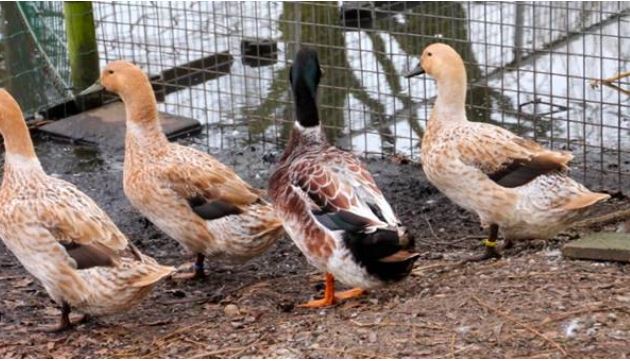Both the quality of their eggs and their eagerness to reproduce have earned Welsh Harlequin ducks a reputation for excellence. As a matter of fact, a single drake (male duck) can fertilize and mate with an entire flock of hens. the ducklings, or females.
This well-liked duck variety is a recent creation. A genetic “mishap” involving some Khaki Campbell ducklings resulted in the creation of Welsh Harlequin ducks.
Welsh Harlequins, like most domestic duck breeds, lack the true ability to fly. They have a very limited range of motion for flight; they can only lift off the ground by a few inches and move forward by a few feet at most.
Welsh Harlequin ducks are typically kept for their eggs, but they can also be harvested for their flavorful, low-fat, lean meat.
You may also want to read about the best duck feed.
History
The Welsh developed this particular variety of duck in 1949. Leslie Bonnet, a local of Criccieth, found a color mutation among a group of newborn Khaki Campbell ducklings.
To solidify the mutation and create an entire flock of ducks, and eventually a new breed, Bonnet began conducting exclusive breeding.
Leslie Bonnet was a writer, scholar, banker, magazine editor, and officer in the British Royal Air Force who also had a passion for duck breeding.
Bonnet and his wife bought a run-down mansion on 25 acres and transformed it into a successful duck breeding business known around the world.
With the publication of Practical Duck-Keeping in 1960, Bonnet established himself as the authority on duck husbandry.
The accomplished farmer-scholar claimed in his book that the Welsh Harlequin was bred to produce a line of ducks with “docile and placid nature” and greater egg production than the Khaki Campbell.

Appearance
The bird’s body proportions are very similar to those of the Campbell: it’s long and lean, with a moderately broad back and chest, widely spaced legs, a moderately plump abdomen, and an oval head with a straight or slightly concave bill. The neck is of medium length and is held nearly vertically. If you want to look like a real forager, you should hold your body at an angle of 20° to 35° from horizontal.
The male resembles a Mallard in appearance; he has a dark head with a green sheen, a white collar, and chestnut shoulders that transition into a white frosted pattern on his back, wings, and down to his cream-colored breast. The tail has bronze and black coloring. Lacking eye-stripes, the female has a cream head with fawn stipples. Her creamy white body, wings, and tail are marked with frosted brown and fawn.
Adult females start out with brown legs, but juvenile males’ legs are orange. In contrast to the yellow/green bills of adult males, adult females have olive-colored ones. While male chicks’ bills are darker at the tip at a day old, females’ are noticeably paler. With an accuracy of at least 75%, this autosexing color distinction is useful for about three days after hatching.
Keeping Welsh Harlequin
The exceptional utility of a harlequin is the primary reason for breeding them. Their adaptability makes them “outstanding layers” of 240-330 white-shelled eggs per year, “active foragers,” “excellent producers” of lean meat, “beautifully colored,” and “almost as clean to pluck as white birds when dressed for meat.” (Holderread)
Pick “robust, strong-legged birds that are free of physical deformities, heavy layers, and of correct body type and color” when selecting a Welsh Harlequin breeding bird. Don’t breed animals that are more than half a pound overweight or underweight, have short, blocky bodies, large, coarse heads, distinct Mallard-like facial stripes, light-colored bills in ducks, or are poor producers if you want to keep the genuine Harlequin breed alive. (Holderread)
They can’t even pretend to fly. If given adequate shelter and fresh water, they can thrive in either hot or cold climates. They are not a frightful species, and they thrive on human companionship. Curios and easily housebroken, they can be let out during the day and brought back to their coop at night. The drakes tend to be more vocal than the ducks, making this a breed with a relatively low volume.

